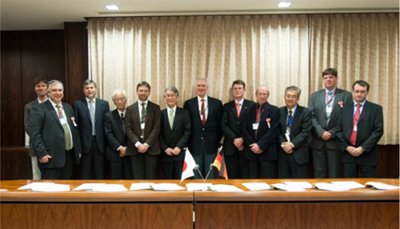URL: https://belle2.desy.de/e103206/@@siteview
Breadcrumb Navigation
Super KEKB and Belle II
From 1998 to 2010, KEK, the Japanese High-Energy Accelerator Research Organisation, operated KEKB, a 3 km circumference asymmetric electron–positron collider thereby reaching the world record in instantaneous luminosity of 2.11x1034 cm–2 s–1. The beam energies were chosen such, that in the collisions mainly B-mesons were produced, which is the reason why the facility is also known as B-factory. The Belle experiment precisely analysed the characteristics of pairs of B- and anti-B-mesons and confirmed the effect of CP- violation as described by the theory of Makoto Kobayashi and Toshihide Maskawa, who both were awarded the Nobel prize in physics in 2008. CP-violation is believed to be one of the origins for the observed dominance of matter over anti-mater in our present universe. However the measured level of CP-violation is by far not sufficient to quantitatively explain the actual asymmetry. Therefore, a much deeper understanding of the related phenomena is required.
Figure 1: KEK is upgrading its B-factory to the SuperKEKB facility (left) to provide a 40-fold increase in instantaneous luminosity by exploiting higher beam currents, a large crossing-angle and squeezing the beams down to nanometre scales. Also the former Belle detector needs to be upgraded to Belle II (right) to cope with the enormous increase in intensity.
SuperKEKB (figure 1 left) is an upgrade project at KEK to increase the instantaneous luminosity by about a factor of 40 to 8x1035 cm–2 s–1. The next-generation B-factory will complement the exploration of New Physics beyond the Standard Model currently being carried out at the energy frontier by the experiments at the Large Hadron Collider (LHC). While the LHC experiments provide a direct probe of the TeV mass scale, high-precision measurements of rare decays and CP-violation in heavy quarks and leptons provide a unique probe of New Physics at these and even higher mass scales through the effects of new particles in higher order processes. In the past, measurements of processes involving internal loops have given access to high mass scales before accelerators were available to directly probe these scales.
Reaching higher luminosity in a collider usually involves both increasing the beam current and reducing the beam size at the interaction point. The original approach for the upgrade focussed on an increase of the beam currents and the beam– beam parameter – the high current option. However, in March 2009 the SuperKEKB design changed course based on ideas of Pantaleo Raimondi from the Italian SuperB project, using a large crossing-angle at the interaction point and squeezing the beams to nanometre-scale to increase luminosity – the nano- beam option. The ambitious goal is to accumulate an integrated luminosity of 50 ab–1 by the mid of next decade, which is 50 times more data than the previous Belle detector acquired.
Because the SuperKEKB accelerator will produce electron– positron collisions at a much higher rate, the detector also needs to be upgraded (see figure 1 right). The data- acquisition system will be redesigned with a network of optical fibres. Trigger electronics will be replaced with a new system. A pixel detector will be added providing better resolution for particle tracking and a new silicon vertex detector will cover a larger solid angle. A central tracking chamber, a time-of-propagation chamber and an aerogel ring-imaging Cherenkov detector are also being newly built. The first beam of SuperKEKB is expected in 2016 and the physics run will start in 2017.
Since November 2011 DESY is also official member of the Belle II collaboration. At the occasion of the groundbreaking ceremony for the SuperKEKB project, which took place on November 18 at KEK, representatives of DESY and of the other German institutes signed a corresponding memorandum of understanding with KEK (figure 2).
Figure 2: Representatives of German institutes participating in Belle II and members of the KEK directorate after signing a memorandum of understanding.





